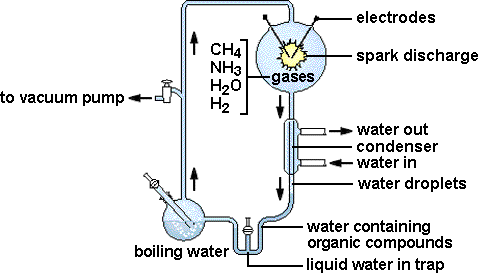The Miller Urey Experiment played a crucial role in investigating the origin of life on our planet. This comprehensive guide explores the experiment’s hypothesis, step-by-step process, key findings, and limitations, shedding light on its significance in unraveling the mysteries of life’s beginnings.
Oparin-Haldane Hypothesis
The Oparin-Haldane Hypothesis, proposed by Aleksandr Oparin and J.B.S. Haldane, postulates that life didn’t spontaneously emerge on early Earth due to different environmental conditions. It suggests that life gradually evolved from chemical reactions, starting with the combination of atoms into inorganic molecules and the subsequent formation of simple organic compounds. These compounds then assembled into complex organic structures, ultimately leading to the emergence of the first cell.
Steps of the Miller Urey Experiment
The Miller-Urey experiment, conducted in 1953 by Stanley L. Miller and Harold C. Urey, aimed to simulate early Earth’s conditions and test the Oparin-Haldane Hypothesis. Here are the key steps of the experiment:

Simulating Early Earth’s Atmosphere: The researchers recreated early Earth’s atmosphere in a closed system using a mixture of gases believed to be present during that era. They used a mixture of gases, including methane (CH4), ammonia (NH3), water vapor (H2O), and hydrogen (H2).
Introduction of Energy: Sparks or electric discharges were introduced to simulate the energy sources on early Earth, such as lightning strikes.
Circulation and Condensation: The gas mixture and energy were circulated continuously, mimicking Earth’s water cycle and allowing for the formation of various organic compounds.
Collection and Analysis: Samples were collected from the closed system and analyzed using chromatography and spectrometry to identify and characterize the organic compounds formed during the experiment.
Results and Findings: The experiment produced a variety of organic molecules, including amino acids—the building blocks of proteins—supporting the notion that early Earth’s conditions could have facilitated the synthesis of organic compounds essential for life’s origin.
Conclusions of the Miller Urey Experiment
The Miller-Urey experiment yielded significant conclusions, including:
- Organic compounds, including amino acids, can be synthesized from inorganic materials under simulated early Earth conditions.
- Basic building blocks of life may have emerged spontaneously from non-living matter.
- The experiment demonstrated the potential for diverse organic compound formation, including rare amino acids.
- External energy sources played a crucial role in facilitating chemical reactions and organic compound synthesis.
- The experiment offered insights into the chemical reactions that might have occurred in early Earth’s atmosphere.
- The findings supported the concept of abiogenesis, where life can arise from non-living matter through natural processes.
- The Miller-Urey experiment laid the foundation for further research in prebiotic chemistry and the study of life’s origins.
Limitations of the Miller Urey Experiment
It’s important to consider the limitations of the Miller-Urey experiment, which include:
- The experiment’s simulation of early Earth’s atmosphere may not perfectly represent the actual conditions.
- The specific gases used may not accurately reflect the true composition of early Earth’s atmosphere.
- The experiment’s short duration and scale may not fully capture the complexity and length of natural processes involved in life’s origin.
- While the experiment produced organic compounds, it didn’t address the assembly of complex biomolecules or replicating systems crucial for life’s origin.
Ongoing Debates and Significance
Critics argue that the experiment oversimplifies the interconnected nature of biochemical systems and may not fully represent the processes behind life’s origin. There is an ongoing debate regarding the specific conditions and pathways leading to life’s emergence, with the Miller-Urey experiment presenting one plausible scenario. While it doesn’t address the origin of genetic information or self-replicating systems, subsequent research has refined and expanded upon its findings, leading to revised interpretations. The Miller-Urey experiment remains a significant milestone in our understanding of prebiotic chemistry and contributes to unraveling the complex puzzle of life’s origin.
In conclusion, the Miller-Urey experiment’s hypothesis, steps, conclusions, and limitations provide valuable insights into the origin of life on Earth. It serves as a foundation for further research, stimulating ongoing debates and refining our understanding of life’s emergence from non-living matter.
Learn more: